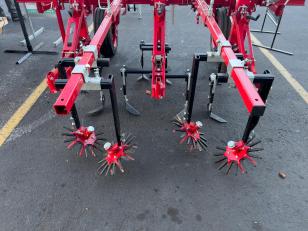photo credit: Ruth Dusseault/Bay City News A robotic weeder that uses no herbicide, at the Organic Growers Summit in Monterey on Nov. 29, 2023.
It’s hard to find a job fighting climate change, oddly. But the organic farming industry is one place where a person can make a living making a difference.
Food systems account for 20% to 30% of global greenhouse gas emissions, according to data from the World Bank. The reinvention of farming could impact the future as much as the electric car.
At the Organic Grower Summit last week, organized by Western Growers and the Organic Produce Network, over 600 growers and industry leaders, mostly from California, met in Monterey to share problems, solutions and business cards.
Big topics included new technologies and new government regulations that could raise costs. Underlying almost every discussion was the regenerative health of soil and its potential for fighting disease, repelling pests and capturing carbon.
California leads the country in organic farming, with over 3,000 certified farms, according to 2022 figures from the United States Department of Agriculture, or USDA. In 2021, the state’s organic sales topped $14 billion. That’s the equivalent of $43 per person in the U.S. buying organic. Just in the greater Bay Area region, spanning from Monterey to Sonoma counties, there are over 1,550 organic producers generating nearly $1.4 billion in annual gross sales.
Gradually, more conventional farmers are moving into organics, some transforming their multi-generational farmlands. They bring business experience, innovations and capital to what was once a niche economy.
“I’m in it for the money,” said Carlos Amaral, a grower from San Mateo County who said he is willing to front the higher production cost because the buyer is willing to pay more in return. Today’s younger shoppers, he said, are more environmentally conscious.
“The thing that I’m excited to see is more lasers.”
—Bart Walker
But by March 2024, organic prices might rise as new USDA rules for organic certification take effect. The Strengthening Organic Enforcement rule, or SOE, will set new standards for everyone involved in production. All the way up the supply chain –growers, distributors, shippers and importers — will need to be organically certified.
“You’re verifying that they understand how to keep things organic,” said Danny Lee, inspector with the California Department of Food and Agriculture. “You will be sure that they’re not co-mingling organic produce with non-organic products, which may have different pesticides or other inputs.”
It is going to be more expensive, he said, but whether it gets passed down depends on who is willing to absorb those costs and what the final retailers are willing to pay.
The summit centered on the unique challenges of specialty crops, things like leafy greens, berries and carrots. They are different than commodity crops, like corn and soy, which are farmed at mass scale using herbicide-resistant seeds and industrial harvesting methods.
Specialty crops need a lot of intense hand labor, and synthetic herbicides like Roundup are not allowed on organically certified farms.
“The thing I see that we have oversaturated is the weeding market,” said Bart Walker, who runs an equipment rental company.
Walker was referring to the array of mechanical weeders on display at the summit. Rather than ask labor to do the back-breaking work of pulling weeds by hand, engineers have designed a variety of machines to do it. Pulled by a tractor, whirling paddles, blades and spikes disrupt the ground between crop rows and keep weeds from taking root.
“The thing that I’m excited to see is more lasers,” said Walker.
“It turns out that having people walk through your field and pull weeds out with hoes and tools will damage part of […]
Full article: norcalpublicmedia.org

